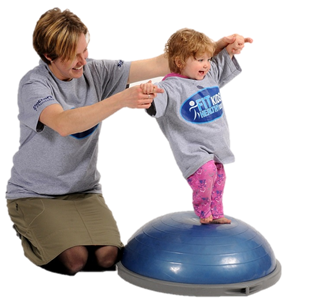| 12 Important Tips to Help Your Child Improve Their Physical Literacy: |
1. Children should have 60 minutes or more physical activity each day.
- This activity should be adult lead with many more hours of active free play.
- It should focus on fundamental movement skills like running, galloping, skipping, jumping, hoping, leaping, kicking, striking, catching throwing, tracking, balance, agility and coordination.
|
2. Active Play should be vigorous and increase a child’s heart rate
- It is important to get your child’s heart rate elevated. A fun activity is to count heart beats together before and after play.
- Playing catch is fun and important. To increase their heart rate, try pairing active fundamentals like running and jumping with less active ones like catching.
|
3. Play with your child - it will keep them moving longer and gets you active as well
- You don't always have to run in the race with them. Be a cheer leader, a retriever or a timer. There are lots of ways to actively engage to keep your kids moving.
- Bonus - the nap the little ones will take after they play!
|
4. Teach them games that they can play on their own or with friends
|
5. Play games that involve many different fundamental (basic) movement skills
- Learning to move will build confidence, competence, and social skills.
- Learning to move will increase educational success and cognitive skills.
- Learning to move will improve fitness, physical health, mental health, self-esteem and self-efficacy.
- Learning to move will inforce healthy lifestyle habits - an active for life attitude.
- Read more about the fundamental (basic) movement skills here
|
6. Remember to encourage activity in different environments: on ice and snow, in the water, on the ground, and in the air
- We understand a need to focus on safety in today’s world but falling down is a part of life. We need to allow kids to fall so they can learn how to get up. When they grow into more fragile adults they will have built skills to avoid injury.
- Walking and sliding on ice and snow are important movement skills to learn in our climate.
- Learning body control in the air through jumping on and off things, can help a person control themselves when they do slip and fall unintentionally.
- Learning to swim and being introduced to water at a young age can help eliminate fears, open a world of activity/fun, and insure confidence and safety awareness when around water.
|
7. Introduce your children to many different sports.
- Participating in multiple sports will help your child to develop into well rounded athletes
- Children who play multiple sports growing up are more likely to excel in the sport they later choose to specialize in.
|
8. Think of active toys, equipment, or experiences when it comes time to give a gift
- Help your child to get excited about activity with simple toys like hoops, balls, balance beams, pool noodles, balance boards, balloons, scarves and other sports gear (we love spoonerboards, bucket stilts, and slack lines to name a few).
- Give the gift of an active experience to your children. A day of waterskiing, high ropes courses, adventure hikes, guided mountain biking tours, learning to snow board, or cross country ski can be great for almost any age.
|
9. Encourage outdoor play with natural elements
- Being outside in the great big world points children in the direction of active play. Nothing gets a child running like a huge open space!
- While bought toys can be really fun, kids like to play with anything. It can help their imagination and learning when they are able to jump in puddles, play in the mud, climb a tree, skip a rock, throw a stick or run in the water.
- Scavenger and obstacle courses are great ways to get kids moving in outdoor spaces.
|
10. Promote creativity and self-expression by using dance and pretend play during activity
- You might think you look silly but your kids will love it - and that's what's most important!
|
11. Minimize coaching and maximize fun
- It's not about perfecting their techique for each skill
- Through repetition, active play, adult demonstration and little teachable moments children will improve their movement naturally and move towards mastery of the skill they are practicing.
|
12. When your kids are young - just focus on the fun
- The best part about sport and activity is playing with your friends and being encouraged by those you love the most: your parents, caregivers, teachers and coaches.
- As your kids get older there will be plenty of opportunities to learn about competition and experience winning and losing. Keep the focus on fun and your kids will grow up fit, healthy kids that are active for life!
|





